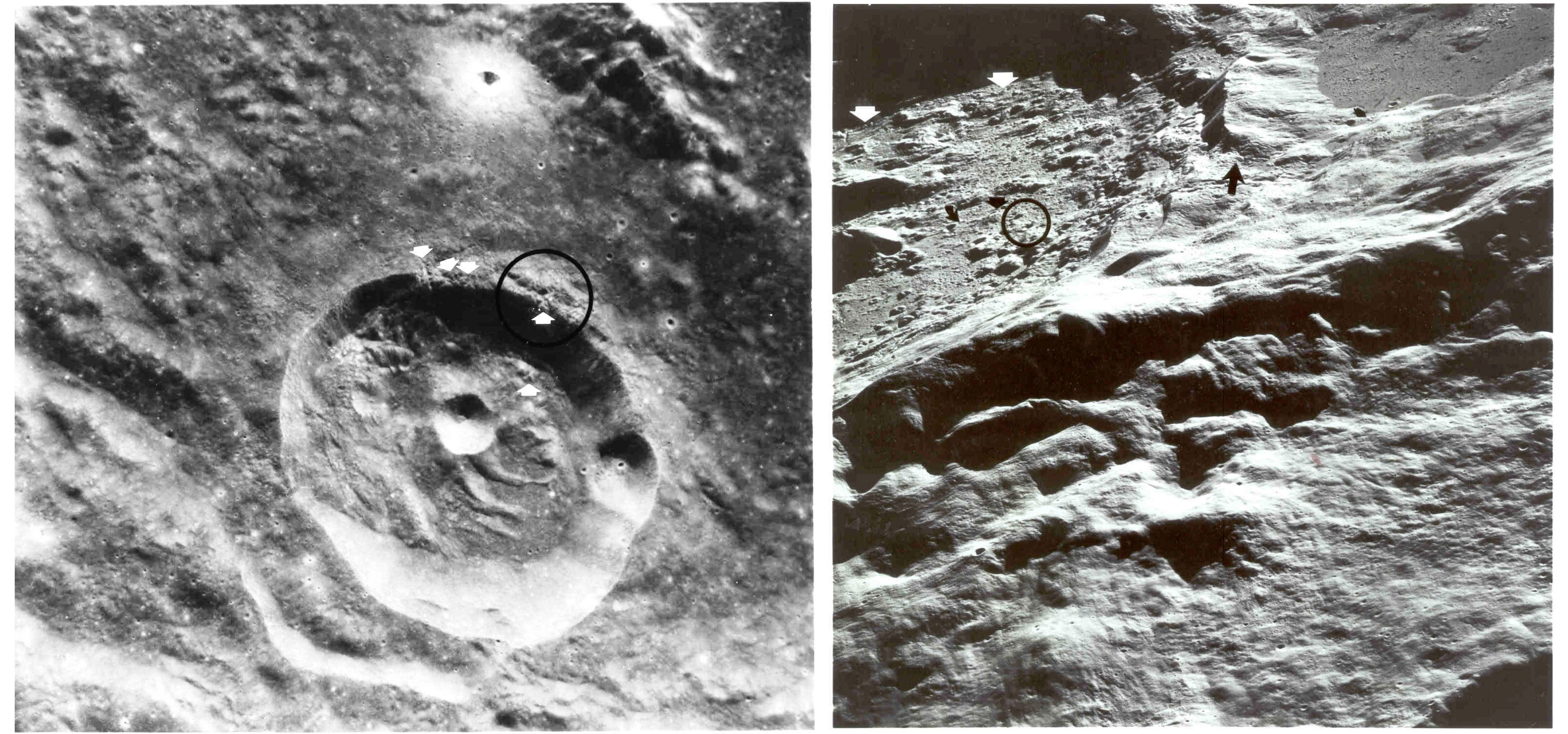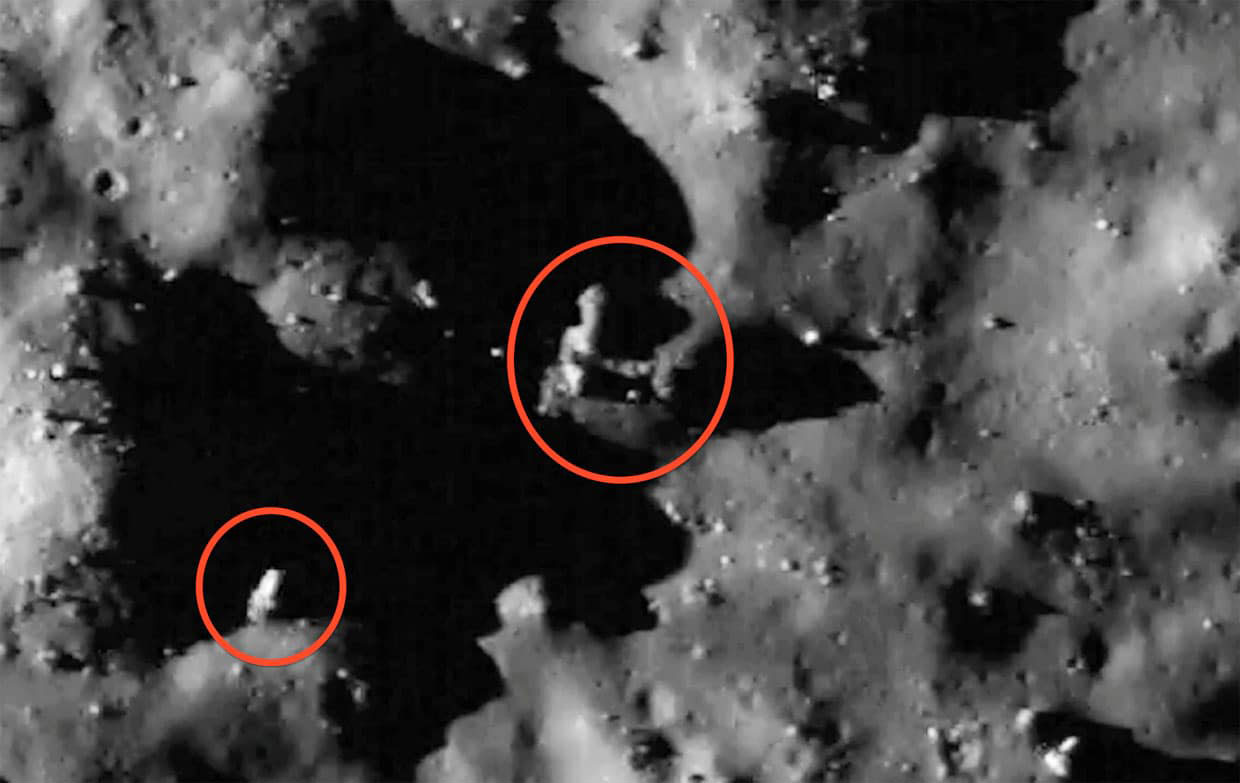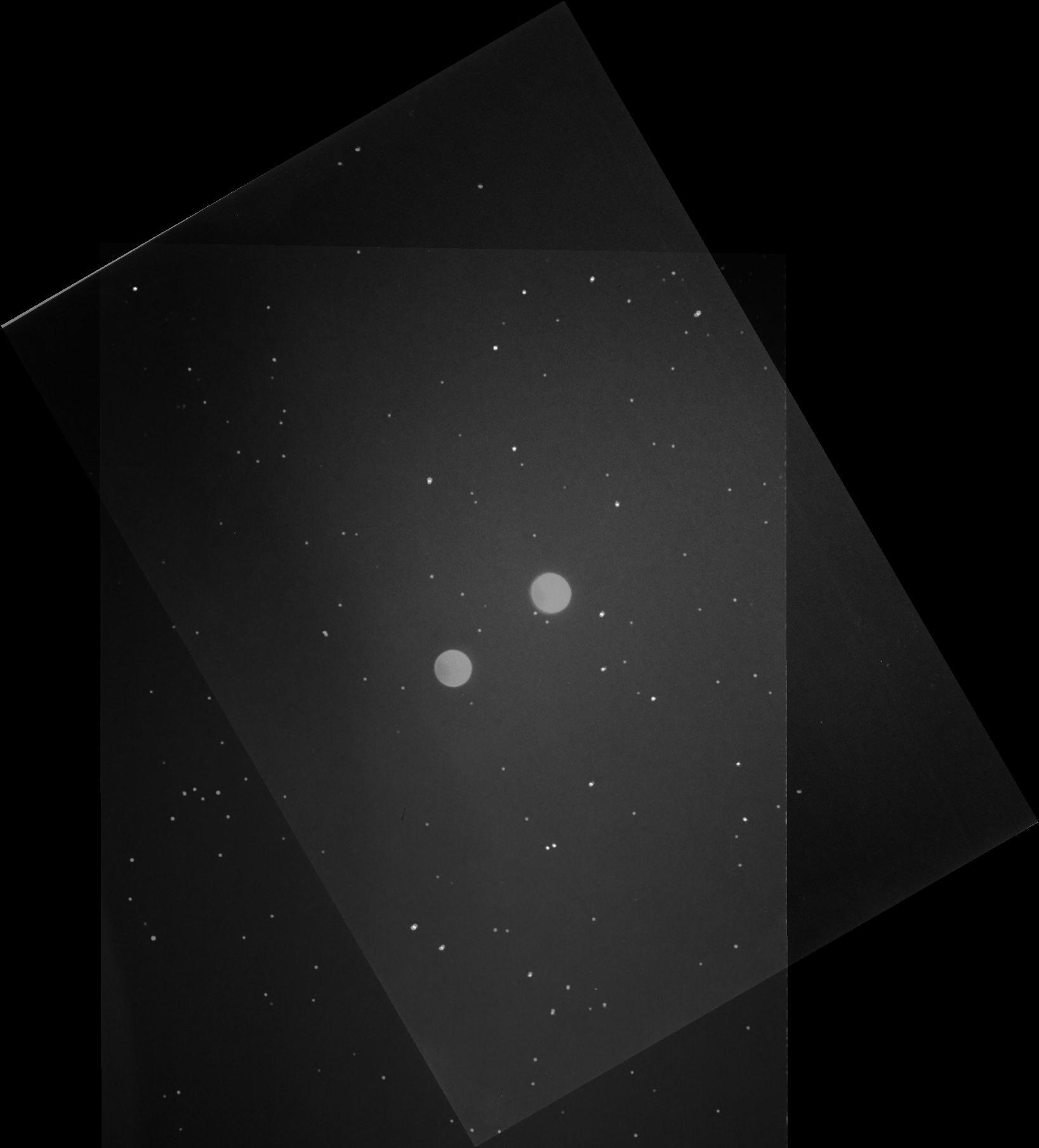Dominique Festa
Somebody Else is on the Moon
Synchronous Rotation
It takes the moon approximately 28 days to revolve around the earth. It also takes the moon 28 days to complete a full rotation around its own axis. This is called synchronous rotation, which means that from Earth, we are only ever confronted with one side of the moon. The other side, the far side, is turned away from us. Always. I wonder why? It seems too great a coincidenceŌĆöthis eternally dark side of the moon.
George H. LeonardŌĆÖs Somebody Else is on the Moon
George H. Leonard wrote on the subject of the dark side of the moon in his 1977 book, Somebody Else is on the Moon. An amateur astronomer, Leonard scrutinized thousands of photographs from NASAŌĆÖs lunar program for evidence of engineered structures on the MoonŌĆÖs surface. A selection of these are supplied in his book, alongside conversations with scientists, astronomers, and NASA insiders. Admittedly, the photographs are hard to make out: low-res reproductions of shots from the Apollo Moon Missions and the Ranger, Orbiter, and Surveyor probes of the 1960s and 70sŌĆöI am also working off a shitty scan. Luckily, Leonard has provided ample hand-drawn sketches which give detail and dimension to the otherwise undecipherable photographic evidence.
The photographs (weŌĆÖll have to take his word for it), show countless intelligent interventions: repeating geometrical patterns, pipes and screws, enormous rigs and gears, metallic objects, lights, and sprays of vapor emitting from vents in crater walls. All this in support of his theory that an alien race occupies the moon, living underground and in hiding, but leaving traces of their activity on the lunar surface, in plain sight, were we only to look for them.
Dominique Festa
Somebody Else is on the Moon
An image of the surface of the inhabited moon in George H. Leonard 1977 book, Somebody Else is on the Moon.
Luna craters are inexplicably shallow; their floors are convex, as though meteorites, upon impact, disturb only a top layer of fine dust on the lunar surface and are then obstructed by an incredibly strong, inner hull. This leads Leonard, and many others, to conclude that the Moon is not a moon at all, but a spacecraft parked in orbit around the earth, syphoning water from our oceans, dumping waste into our atmosphere. Perhaps a broken spacecraft, in the process of being mended, as evidenced by stitches that appear to patch ruptures in the lunar surface.
Dominique Festa
Somebody Else is on the Moon
NASA images of the surface of the Moon.
A final experiment in the Apollo 12 mission saw their spent Lunar Module crash into the Moon. Seismic equipment installed for this purpose registered reverberations that lasted over an hour. The moon ŌĆ£rang like a bell.ŌĆØ1 Like something hollow. The Hollow Moon hypothesis, first proposed in H. G. WellŌĆÖs 1901 book, The First Men in the Moon, and later by Michael Vasin and Alexander Scherbakov of the Soviet Academy of Sciences in their 1970 article Is the Moon the Creation of Alien Intelligence?, depicts the moon as a planetoid hollowed out by intelligent life and driven into the EarthŌĆÖs orbit.2 A similar, contemporary theory from BBCŌĆÖs David Icke takes the moon for an ancient and long abandoned space ship, the body of which could once have housed an entire nomadic civilizationŌĆöa ŌĆ£NoahŌĆÖs Arc of Intelligence.ŌĆØ3 Theories as to what became of this civilization build off of other theories contending that the Earth has been periodically visited, or might currently be populated by these aliens. In 2015, Crow777 observed a ŌĆ£lunar waveŌĆØŌĆöan anomaly usually encountered with projected imagesŌĆötraverse the moon. What we see night after nightŌĆöthat self same moon, perpetually and irrationally turned towards usŌĆöis a hologram concealing an artificial station and alien civilization behind it.4
Skywatchers and the Decent Moon
In 2013-14 Darkskywatcher74 organized a number of Moon monitoring sessions on Ustream. His goal was to collect enough participants around the globe to pick up video feed from where the last telescope left off, keeping a constant, live eye on the Moon. Members of the community, some 1400 people, were invited to band together and monitor the Moon for lunar transient phenomena (LTP): UFO and meteor impact, lunar waves, lights, shadows, and other anomalies. The project has since mostly fallen apart, but the sessions have been archived, and one can watch them too, albeit from the future, for the odd, seldom black speck moving fast as hell across the lunar surface.
And one must watch, ŌĆ£Because NASA wonŌĆÖt do it.ŌĆØ5 This is the Darkskywatcher74 (DSW) slogan. A powerful call-to-arms that embodies the burden of responsibility felt by members of the fringe to uncover a truth held captive by whomever: scientific discourse, the high-high-higher-ups, aliens?
DSW seconds as an amateur news outlet with energies now directed towards following the Trump rallies of the US 2016 election campaign. The better, and still active channel is live space cam lunar and solar, broadcast by Pgirnus out of Miami.6 Compared to the DSW Observatory or NASAŌĆÖs ISS live stream, his is a quieter channel, with a smaller following; two to eighteen viewers tune in at any given time to either watch the Moon or the Sun or the Star Trek reruns playing between feeds. The chat function is seldom used, and when it is, the discourse is incredibly wholesomeŌĆöjust the intermittent ŌĆ£great channel!ŌĆØ and ŌĆ£Merry Christmas yŌĆÖall!ŌĆØ. Rather than record himself during live streams, which other observatories are prone to do, Pgirnus plays audio recordings from various radio programs; the content is thematically relevant (alien abductions, theories of synchronicity, the hybridization of humans and chimpanzeesŌĆ”) but he gives no introduction or contextualization to the audio. Who knows what weŌĆÖre listening to or why, but it contributes to the ambience of the site as a late night respite tailored to the amateur astronomer, the sci-fi junkie, the chemtrail theorist, etc. It is beautifully curated.
The archived videos are given simple, pointed titles and nothing is ever capitalized: ŌĆ£bad seeing condŌĆØ, ŌĆ£camera dies againŌĆØ, ŌĆ£decent viewsŌĆØ or ŌĆ£dont waste your time looks terribleŌĆØ. A person of economic diction, Pgrinus uses the time stamp to communicate with us the imperative and bare minimum. You can watch in real time as he erases ŌĆ£live 12/15ŌĆØ letter by letter and types out his dispatch, ŌĆ£never seen that b 4ŌĆØ, fixing spelling mistakes along the way, ultimately replacing the dispatch again with ŌĆ£live 12/15ŌĆØ or whatever date. The feed runs for 1-3 hours. If you can catch his chance messages, the sense of discovery is not dissimilar to having caught a glimpse of that odd, seldom black speck crossing the surface of the Moon.
Dominique Festa
Somebody Else is on the Moon
NASA images of the surface of the Moon.
The Double: An Uncanny Harbinger of Death?
The lack of information about the Moon, and especially its far side, represents a profound void in the picture we have of our universe. A void that, again, does not appear empty, but merely obscured; a body of knowledge lying in wait for disclosure, shrouded in the coverup. And so attacked from the outside with popular epistemology, using hacked data and cobbled-together equipment, the void is plotted and mythologized by disparate factions. Their search is material. It manifests in hours and hours of footage of the Moon (the same-ish Moon, some nights cloudy and some nights clear), meticulous analysis of LTPs exposed through synthesis on YouTube, debates suspended eternally in comment sections and chatrooms, the silly Somebody Else is on the Moon (by now discontinued, rare and expensive).
If the stories we come up with to explain the void of the dark side appease the emptiness, it is only for a moment. Ultimately, the stories are empty too. They dream up new terrors and punch out new holes. Just how benevolent are these aliens in the Moon? Which perspective provides more comfortŌĆöthe lone and unique planet Earth with its lone and unique life source or the many worlds and many lives promising the free transference of spiritual and scientific knowledge or else intergalactic warfare and mutual annihilation? Does this make the universe comprehensible or chaotic, meaningful or meaningless?
The Moon is double. On one side (d1) is the true Moon, and on the other side (d2), a false moon. If the true Moon is the Moon as it is popularly understoodŌĆöEarthŌĆÖs innocuous satelliteŌĆöthe false moon could be any number of conceptions that threaten the sanctity of the popularly understood Moon. It could be LeonardŌĆÖs moon, the hollow moon, or the hologram of a moon. For live space cam lunar and solar, everything flips. The popularly understood Moon is the false moonŌĆöa lied about, covered-up, masqueraded moon. But they appear the same, the Moon we know and the false moon, which is to say that what we see in the night sky are the distant, but familiar features of a singular Moon.
Dominique Festa
Somebody Else is on the Moon
NASA images of the surface of the Moon.
What we donŌĆÖt see, or rather, donŌĆÖt necessarily recognize that we see, is the imprint of both conceptualizations of the Moon on the Moon. The other thing we do not know that we see is ourselves reflected in the Moon. The double exists by virtue of the to whom. Its doublenessŌĆöwhich appears singularŌĆöimplicates us in the image of the moon. But where exactly? Happily, Slavoj ┼Įi┼Šek triangulates our precise location on the Moon in his master work, The Parallax View. The parallax occurs when a distant object appears to move against a backdrop as it is viewed from changing perspectives. If you stare straight ahead at your outstretched arm and outstretched finger, moving your head from side to side, your finger moves too. From the right, it blocks from view the chair to your left, and from the left it blocks the view of your cat on the right. Or whatever is there with you, behind your finger. ┼Įi┼Šek appropriates this phenomenon for his parallax gap and reads it through Lacan: ŌĆ£The subjectŌĆÖs gaze is always-already inscribed into the perceived object itself, in the guise of its ŌĆśblind spotŌĆÖ, that which is ŌĆśin the object more than the object itselfŌĆÖ, the point from which the object returns the gaze.ŌĆØ1 The fact of the blind spot implicates the subject in the constitution of the object, or to put it another way, the to whom is the dark side of the Moon. Like reality, the Moon can never appear as a whole, but always incomplete, blighted by blindspots, dark sides, to whoms.
Dominique Festa
Somebody Else is on the Moon
Illustration of the parallax gap, whereby the to whom is implicated by the dark side of the Moon and made double.
A Hyper Artificial Pink and Slippery Moon
When viewed through a telescope, the moon ripples, like a mirage on the horizon. This is a consequence of atmospheric seeing where light is distorted as it travels through thermally turbulent atmosphere. This is why stars twinkle, why high heat is hazy, and why the Moon sometimes appears liquid. Atmosphere also influences color, casting the Moon in pink, green and yellow hues. Add to this the clouds which pass over the lunar surface in quick succession and from out of the shadows, and as a consequence of this great contrast in value, the Moon emerges each time brighter. It is not simply dark and then light, off and then on; there is an emergent quality to the illumination of the Moon as the clouds slip off and away, return and repeat. Sites on the Moon, such as the Tyco and Copernicus craters, are bright against the lunar seas, lit in a fashion not dissimilar to a time lapsed city turning on in its lights at nightŌĆöa pocket of fiber-opticesque light that fans out towards the suburbs. Artificial, but resplendent. And you will see something there. You have to. The rippling, the noise on the footage, the changing light, provoke an optical confusion. The craters will invert. The lunar sands will dance. Little grey men will tunnel out of the soil ŌĆ”
It is not for obvious reasons that the Moon is best seen at night. For one thing, the night is painstakingly quiet. Leading by example, the night proceeds with prudent steps, heel-to-toe, heel-to-toe, hugging the baseboard where the floor is least likely to creak, operating cabinets and drawers with a sloth-like composure. We all follow suitŌĆöbleary eyed and stepping soft, charged with the nightly preservation of the sacrosanct silence. Sacrosanct sleeping. Lying down. Prostrate. Supine.
The night is base. It is the day stripped of light, color, noise, and whatever other activity. It falls quiet, does not distract the mind with extraneous stimuli. Clean. The night is supine. It is both a condition of the to whom (the paralyzed body) and also a performance of the to whom (the corporal mortification to arrive at or genuflection at the feet of a numinous double). And the night is dark of course. But not too dark. Not with the Moon seen from Miami fed through luminous screens into our bedrooms and basements. In the earliest hours of the morning, we commune with two to eighteen other sky watchers, looking for something we do not know. Something we will recognize by the long forgotten and wholly other. A seance across oceans, across screens, the lunar and solar channel is a kind of paramediation, which we carry out night after night. Repeating the search taken up by our primitive ancestors and ancient astronomers. Simulating again this circumvention of the void, like a terrible, profound, and endless d├®j├Ā vu.
The night is dark. But not so dark as all that. Not with the Moon keeping us company as we spin idiotically in our great void. Until the telescope malfunctions, or our computers die, or Pgirnus turns off the feed and the screen goes dark. We lose the Moon, we lose the light. For sure, we toy with the idea of playing the next video from the archive (the rerun doesnŌĆÖt do too much to shatter the illusion of the search), or of finding another live stream or whatever. But ehh, it is so early in the morning and I think weŌĆÖre more tired than we know. Better to paw around for the bed. To lay down now, to shut our eyes. On our backs, in the dark.
-
"Spaceship
MoonTheory," Ancient Aliens, 2011, accessed December 04, 2016, https://ancientaliens.wordpress.com/2011/09/04/spaceship-moon-theory/ ↩ -
Leonard, G. H. Somebody Else Is On The
Moon(Anacortes: R. S. Marshall, 2013), 66. ↩ -
Austin, Jon "David Icke claims the
moonis HOLLOW and built by ALIENS in crazy new theory" http://www.express.co.uk/news/weird/674711/David-Icke-claims-the-moon-is-HOLLOW-and-built-by-ALIENS-in-crazy-new-theory.accessed. Accessed December 05, 2016 ↩ -
"Do You Believe the
Moonis Real? Because Analysis Shows it Might be a Hologram" https://ufoholic.com/conspiracy/do-you-believe-the-moon-is-real-because-analysis-shows-it-might-be-a-hologram/. Accessed December 04, 2016. ↩ - https://www.facebook.com/darkskywatcher74/ ↩
-
http://www.ustream.tv/channel/live-space-cam-
lunar-and-solar ↩ -
Slavoj ┼Įi┼Šek, The
ParallaxView (Cambridge, MA: MIT Press, 2006), 17. ↩
About the author
Dominique Festa graduated with the Sandberg Instituut's Materialisation in Art and Design Temporary Master program in 2017. She is currently based in Los Angeles, CA.




